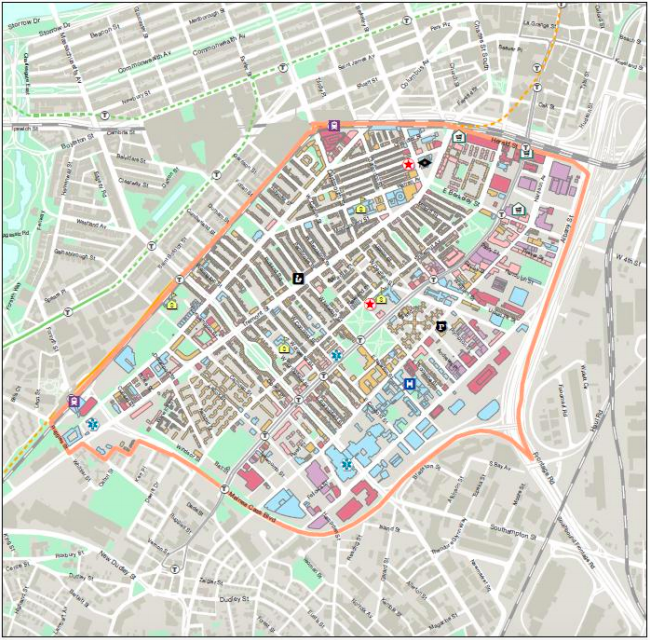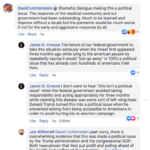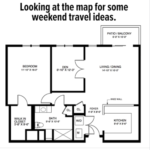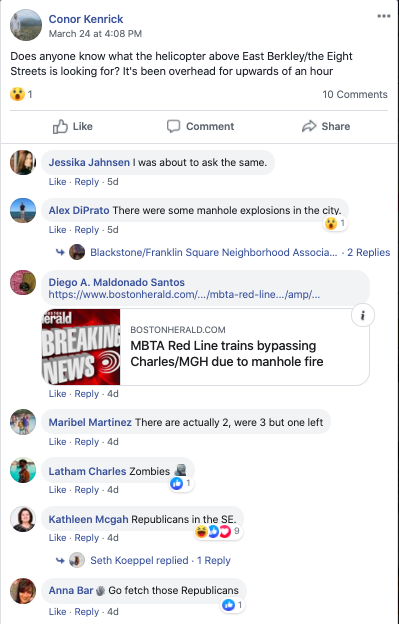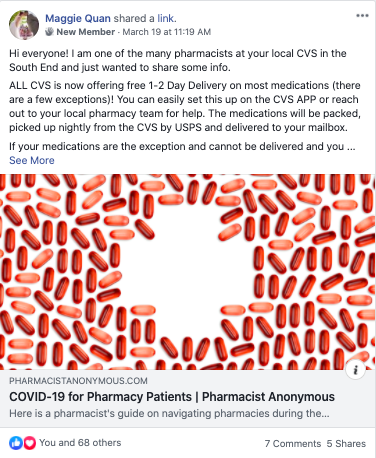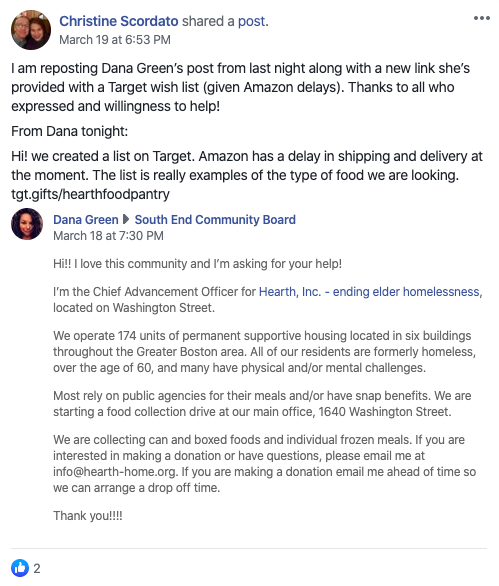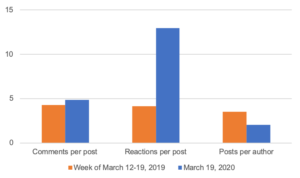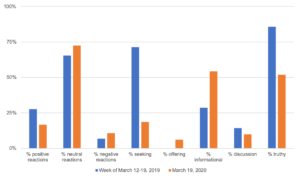NOTE: I have left all names in screenshots as the South End Community Board is a public, visible group on facebook.
It’s hard to ignore the growth of Facebook Groups, whether you’re an active Facebook user or just a lucky consumer of the widespread “More Together” ad campaign. As of April 2019, more than 400 million people were in groups that they found meaningful (as determined by Facebook through surveys and engagement metrics).[1] It would appear that up to 6,000 of those people are members of the South End Community Board (SECB), a lively Facebook Group dedicated to the South End neighborhood of Boston.
To a casual participant (like the author, who has used the group… twice… to see if anyone found her podless AirPod case on a sidewalk), SECB seems like a fairly healthy online community thanks to adherence to the posted guidelines, the helpful or humorous tone of most posts, and member engagement. Yet, like any healthy community, not all exchanges are completely “positive” nor is SECB immune to exogenous shocks like the COVID-19 pandemic. As coronavirus spreads across Boston and the world, does a neighborhood Facebook Group need to adapt, and if so, how?
Background
South End Community Board
SECB was created as a Facebook Group by Stephen (Steve) Fox on April 25, 2015. The group is visible and public, meaning anyone can find the group and see who’s in the group and what they post (including comments on others’ posts) – no Facebook login necessary. As of March 29, 2020, the group had 6,310 members, 62 of which had joined within the past week. Membership included two admins and 33 Facebook Pages, most of which represented local businesses and politicians. The other group members were presumed to be individuals living and/or working in the South End. While Facebook does not provide a dashboard for group members, a sample of the member list reflected a college-educated majority and a notable concentration of educators and health care workers.
Steve Fox
Fox has lived in the South End since the late 1980s. He has long been active in the community, co-founding the South End Forum in 2002 as an umbrella for the 17 distinct neighborhood and business associations that advocate for the South End.[2] In addition to administering and moderating SECB, Fox serves as chairman of the South End Forum and advisor to Friends of the South End Library.
South End neighborhood
The South End is a one-square mile neighborhood of Boston with 31,669 residents as of the 2010 U.S. Census.[3] This suggests up to 20% of residents were SECB members as of March 2020, though the actual share is likely lower given the number of non-person and non-resident members and even accounting for population inflow since 2010. Compared to the city of Boston overall, South End residents as of 2015 were more likely to be white (55% vs. 45% for the city), more highly educated (65% with bachelor’s degree or higher vs. 45%), and earn more ($77,161 median household income vs. $55,777).[4] Today, the neighborhood is just one example of rapid gentrification as high-end restaurants and luxury real estate developments abut historic gay bars, Puerto Rican housing communities, and Methadone Mile.
How SECB Operates
Purpose
As stated in the group’s description, SECB exists as, “A respectful and open discussion area for Boston’s South End residents and neighbors on just about any matter of interest, opinion, or community public notice.”[5] Topics vary widely but follow exhaustive guidelines / posted etiquette, which are strictly enforced by the two group admins. Recent memorable postings included an ask for a spare 3V CR1225 battery (the kind that fits most digital thermometers), an update on which stores have toilet paper in stock, and an offer for no-contact dog walking.
Guidelines
Like most of today’s online communities, SECB operates under guidelines that encourage healthy activity. The guidelines are clearly posted in the group’s description and are updated sparingly. A notable change was made following a steady increase in members posting screenshots or video clips from their Ring doorbells (or similar surveillance), after which Fox added, “Because video can be a valuable tool to help police to identify and potentially arrest individuals for criminal activity, we ask Board members to send any video or photographic footage that might help the police to ID a suspect quickly and directly to the BPD [Boston Police Department].” In addition, as SECB is a public group, members likely (or should) think twice before posting, commenting, or reacting, as their activity is visible and identifiable to anyone with Internet access.
Two specific guidelines that this Craigslist love-hating author particularly appreciated were 1) no “veiled or outright” ads, except for real estate for lease or sale by current occupant or owner, and 2) “members posting any for sale items MUST include price.”
Ongoing challenges
Even with a comprehensive set of guidelines, online communities are prone to occasionally go off the rails. While having just two groups admins made it easier to be consistent in how SECB is moderated, it also meant the board only has two people as checkpoints on potential misinformation, misrepresentation, or other miscellaneous nastiness. Especially with the tremendous uptick in posts – 81 on March 19, 2020 versus 7 for the week of March 12-19, 2019 – Fox and his co-admin faced a growing fight against SECB activity that violated posted guidelines.
Competitors
SECB is one of many neighborhood-specific Facebook Groups and faces additional competition on other platforms, including Nextdoor. However, SECB seems to dominate in size and overall activity thanks to its broad purpose. Other publicly visible groups are more interest-specific, such as Buy Nothing South End, Boston, MA (594 members, 50 posts in last 30 days), Boston South End Parents (553 members, 37 posts in last 30 days), and South End Young Professionals (188 members, 54 posts in last 30 days).
Measuring Digital Community Health
The following metrics were used to evaluate the online health of SECB:
- Member activity: Volume of posts and comments served as an important reflection of how much members were engaging with content. A bulletin board could be evaluated with read-only metrics, but with a community discussion, it felt important to understand how much people were adding their own input.
- Tone of posts: Facebook’s built-in “reactions” were sorted into three rough categories – “positive” included Love❤️ and Haha😂, “neutral” included Like👍 and Wow😮, and “negative” included Sad😢 and Angry😡. These reactions were used as a proxy for the tone of each post, which would otherwise have been subjectively evaluated by the author. Reactions were also an additional gauge of member activity.
- Breadth of topics: Posts were tagged to categories as applicable, including those seeking something, those offering something, purely informational posts, and discussion-opening posts. Seeking and offering posts were mutually exclusive, but other category combinations were allowed, e.g. discussion-opening and informational, offering something and informational, or seeking something and discussion-opening (provided the discussion was about something besides what the original author was looking for, such as a restaurant recommendation).
- Breadth of authorship: Posts were categorized based on authorship by a business vs. an individual, and grouped to determine the number of unique authors in a given timeframe.
- Truthiness: Posts were labeled “truthy” if they linked to a credible external article or source, included fact-based claims, and/or cited specific evidence in the body of the post.
COVID-19 escalated in local importance beginning March 5, 2020, when the first Biogen conference infection was reported, and was declared a pandemic on March 11. To capture a before and after comparison while minimizing seasonal variability, metrics were gathered for the week of March 12-19, 2019 and for the day of March 19, 2020 (original intention was to collect metrics for the entire week in 2020 as well, but there proved to be too many posts for this to be feasible).

Pre-pandemic
SECB in March 2019 was a pleasant enough place to be: with just 7 posts for the week, but a healthy 4.29 comments per post on average and only 7% negative reactions, members seemed to be engaging positively with each other. An impressive 86% of posts were “truthy”. Unfortunately for the burden on SECB admins, there were only two unique authors during the week in question, and Fox was one of them.
During pandemic
Fast-forward to March 2020, and SECB had become a different place, as had most news and media channels. While overall posts jumped to 81 in just one day, member engagement kept up with 4.86 comments per post on average. Reactions increased substantially, from an average of 4.14 per post pre-pandemic to 12.9 per post on March 19, 2020. The tone of reactions also became more neutral or negative, from 28% down to 17% “positive” and 7% up to 11% “negative”. Unfortunately, share of “truthy” posts went down substantially to 52% – likely related to the increase in number of unique authors, many of whom were more casual posters than Fox (though none of the posts appeared to be clearly “fake news”).
On the brighter side for overall community health, the pandemic period saw an increase in people offering something, from 0% up to 6%, and a consistent flow of informational posts, from 29% up to 54%. There was also an impressive increase in author diversity, with 40 unique members posting in just one day. Discussion-opening posts also remained fairly constant, from 14% to 10%, which is a positive reflection of how members continue to turn to SECB to have a variety of open conversations, regardless of a global crisis.
Planning for the future
New and anticipated challenges
Pressure on health care workers: South End is home to Boston Medical Center, the largest safety-net hospital and Level I trauma center in New England according to Wikipedia. Its proximity to Boston University, Northeastern University, and Longwood Medical Area also makes it a popular neighborhood for current / future / past health care professionals. As COVID-19 continues to spread in Boston, Fox should anticipate further changes in the tone of SECB based on the needs of local residents and businesses.
Reliance on hospitality industry: While many restaurants in the South End have remained open for take-out and delivery only, even more have completely shut down their operations with no clear path to re-opening. Much of the neighborhood’s economy relies on locally-owned restaurants and retail stores, which suffer most in a time of social distancing and e-commerce domination. Fox should anticipate that customers, employees, and managers of local shops will take to SECB to seek help and support.
Slowdown in real estate development: South End real estate prices have risen impressively, to the chagrin of many long-timers, and were expected to continue their upward trajectory based on a number of high-end developments under way. While the long-term impact of COVID-19 is impossible to predict, it is likely that a broader economic softening will lead to less active real estate markets. Many of the more contentious SECB posts in the past have related to new developments, so this may actually be a win for Fox in that he will not have to deal with as much negativity, but also poses an additional threat to the neighborhood’s economic liveliness.
Choices to consider
The easiest thing for Fox to do is stick with the status quo. There is nothing alarming in the health metrics examined, and certainly nothing in particular that demands an immediate change in how SECB operates.
The risk with doing what’s always been done, however, is that SECB misses an opportunity to go above and beyond. As many people have said in the past weeks, “never waste a good crisis”. Fox could, for example, double-down on Facebook’s existing effort to bring more coronavirus-related updates into every section of Facebook, including Group pages. SECB could become a place that follows up on and emphasizes the latest local / state / federal directives, which it already does to some extent through informational postings, but not systematically.
Finally, Fox could take a leap and reframe SECB as an opportunity to step up in local leadership. The group could be used as a way to connect entrepreneurs, organize volunteers, and/or orchestrate legislative initiatives, all in response to COVID-19 (and potentially future relevant challenges). This would mean a substantial departure from the group’s current format, but if done well, would also make the most of an already-healthy online community.
What would you do?
[1] https://www.cnbc.com/2020/02/16/zuckerbergs-focus-on-facebook-groups-increases-facebook-engagement.html, accessed March 29, 2020.
[2] http://realestate.boston.com/buying/2017/09/14/what-is-it-like-to-live-in-the-south-end/, accessed March 29, 2020.
[3] https://www.cityofboston.gov/Images_Documents/South_End_Planning_District_Profile_tcm3-13007.pdf, accessed March 29, 2020.
[4] http://www.bostonplans.org/getattachment/7987d9b4-193b-4749-8594-e41f1ae27719, accessed March 29, 2020.
[5] https://www.facebook.com/groups/SouthEndCB/about/, accessed March 29, 2020.
BOARD POSTING GUIDELINES/ETIQUETTE:
A respectful and open discussion area for Boston’s South End residents and neighbors on just about any matter of interest, opinion, or community public notice.
Veiled or outright advertising posts, including for rent and other real estate purchase offerings–unless by the current owner or lessee–are not made to this Board since they could quickly overwhelm through sheer numbers. We encourage timely announcements of city or other service opportunities, events, new business openings, fund-raisers or community events likely to be of interest to South Enders.
South End businesses that wish to provide an occasional notice of a limited offer, a thank-you “deal”, or holiday event “special” targeted specifically to South End neighbors may do so as an informative neighborhood public notice rather than routine advertising of the business or “today’s pasta special.” Notices by SE businesses, non-profits, neighborhood organizations or individual neighbors of charitable events or sponsorship opportunities are always welcome on the Board. Members posting any for sale items MUST include price.
This is especially a place to thoughtfully discuss new ideas that will help the South End continue to be the most welcoming neighborhood in the city.
Board posts should always demonstrate a basic respect for all members, for the broad South End community, and for those who might be unknowingly identified either through language or images. We ask that posters show both restraint and courtesy by refraining from insensitive or insulting commentary, accusation, or clearly hostile suggestions.
Posts that seem deliberately designed to needle, insult, poke someone in the eye, shame, bully, start a fight, troll, or employ offensive or insulting language are not welcome. While this is a public Board, a poster’s right to express what they want ends where other members’ and posters’ rights begin. The key is to consistently show simple respect.
POSTING PHOTOS OR VIDEO OF SUSPECTED CRIMINAL ACTIVITY:
Because video can be a valuable tool to help police to identify and potentially arrest individuals for criminal activity, we ask Board members to send any video or photographic footage that might help the police to ID a suspect quickly and directly to the BPD.
If you witness, capture, or experience a criminal act, immediately report it to 911. The police cannot investigate or take actions to ID suspect unless a report is made. Tell the police you have video or stills and provide it to them as part of your report.
DO NOT POST these videos here in the mistaken belief that alerting your neighbors, will somehow help to locate a suspect. Even if another neighbor happens to see a person in a posted video and reports it to the police, the police are limited in how they can respond without probable cause, with no suspect description, no actionable complaint.
https://www.facebook.com/groups/SouthEndCB/
